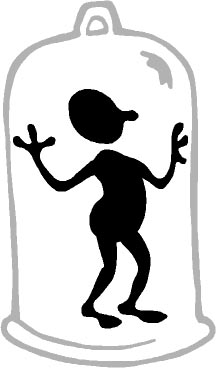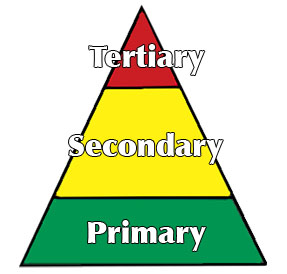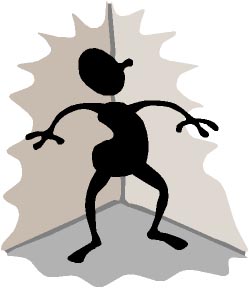

"Time out" refers to an intervention in which you remove a misbehaving youngster from a situation or environment that is reinforcing the inappropriate behavior. People show behaviors in situations because some benefits come to them for having done so. Kids wouldn't show misbehavior in your classroom unless it was being rewarded in some way (e.g., prestige, attention, avoidance of work, revenge against a mean teacher, etc.). When "time out" is used correctly, it keeps the youngster from attaining reinforcement for the "bad" behavior. Now, instead of getting rewards for inappropriate behavior, the actions result in removal from the rewards. The behavior of concern now brings no "payoff". It should then "reach extinction" (die out).
 PBIS tiers addressed by this intervention approach:Tiers 2 and 3
PBIS tiers addressed by this intervention approach:Tiers 2 and 3
There are differing views as to whether time out
interventions should have a punishing effect,  or just be a neutral situation in which the youngster is expected to calm
down and re-enter the learning situation. You will want to think
carefully about the matter to avoid parental/student/district/legal action
against you.
or just be a neutral situation in which the youngster is expected to calm
down and re-enter the learning situation. You will want to think
carefully about the matter to avoid parental/student/district/legal action
against you.
There are two general types of time out procedures.
In one, we remove the youngster from the learning environment to another
location
(exclusionary or seclusionary
type). In the other, the student remains in the learning
situation (non-seclusionary/non-exclusionary),
but is unable to gain reinforcement for a period of time.
Examples include:
-a set aside time out room staffed by a monitor. These rooms vary in size from that of a large walk in closet to a small classroom with seats. They can vary from padded walls and floors to standard walls devoid of decoration.
-a carrel placed in the back of the classroom away
from the instructional area
-a taped off area in the hallway (across from the
door so that you can monitor the student)
The appropriate focus of time out is to provide a safe place for the youngster to become calm. It is not meant to be a punishment. Some time out rooms have the thermostat turned up too high, a number of non-functional lights, wobbly and uncomfortable desks, and maybe a smelly food item placed behind the radiator. This environmental state is designed to make the time out setting a undesirable place to be assigned. These modifications are questionable as they border on punitiveness. While the noxious conditions promote the urge to do whatever is required in order to return to the learning environment (and avoid return by behaving well there for the teacher), it is best to promote appropriate classroom behavior via positive means.
It is important to collect and archive data regarding the youngster's stay in the time out setting. Information of importance might include the reason for being there, time of entry, behavior while in the room, time to a calm state, time of exit, description of follow-up exit conference, etc. Some time out monitors require an exit interview or essay in which appropriate behavior is identified along with strategies for reaching that goal. Of course, gathering this information requires an attentive monitor.

The time out room option should not be the last step in your sequential hierarchy of interventions. If it is the last thing on your list, you'll end up battling with the youngster to get him/her to go there and probably end up calling some big beastly guy to drag the kid to the room. To avoid all the histrionics and physical confrontation, use it somewhere in the middle of all your intervention steps. In that way, you can give the student a choice...going to the time out room or accepting the next consequence on your list (e.g., visit to the office, call home, detention, etc.).
Be knowledgeable of your district's policies on time out, seclusion, and restraint. The room should also be surveyed by the local fire department to ensure that the youngster could escape in case of smoke/fire. Locked doors are to be avoided. If the time out monitor panicked during a fire situation or was overcome by smoke, the youngster would be trapped.
.
| Read Dr. Mac's B-list post on preventive measures and alternatives to seclusion & restraint. |
| Read an interview with Dr. Mac about Using Time Out in the Home |
Non-Exclusionary/Non-Seclusionary
In this version, the student remains in the instructional setting, but does not receive any reinforcement while remaining there. S/he can continue to learn by observation, but may not be an active participant. We do not allow them to offer answers, receive points or raffle tickets, engage in hands-on activities, or converse with a group of others.
Examples include:
-a "head down" (student folds arms on desk top and
lowers face into arms for a designated
period of time)
-removal of "learner badge" for a period of time
(students are allowed to wear their elaborate
self-made paper plate "badges" (complete with ribbons, glitter, stickers,
etc.) as long as
they are "good learners")
-having to move back a few feet from the rest of
the group which is seated on the rug for
"calendar time"
Some Side Notes
-If you're timing out younger kids, the often read
recommendation is one minute per year of age.
(Gosh...you'd have to time
me out for the better part of an hour!)
-Consider "helping" the child to display the required
act, and then rewarding him her. This approach is much preferred to time out in
that it teaches the correct behavior, thus eliminating the need for time
out.
-Time out is not meant to be a "break" or retreat
for the teacher. It should be done in the best interests of the youngster.
Resources
You can find more on the appropriate use of time out procedures at
The
Behavior Home Page www.state.ky.us/agencies/behave/bi/TO.html
www.bcc.ctc.edu/childcare/TooManyTimeOuts.doc
http://www.allaboutmoms.com/timeouts.htm
http://www.nncc.org/Guidance/sac13_word.timeout.html
![]()
| Fetch Dr. Mac's Home Page |
or you'll be timed out in the dog house.
Author: Tom McIntyre at www.BehaviorAdvisor.com
